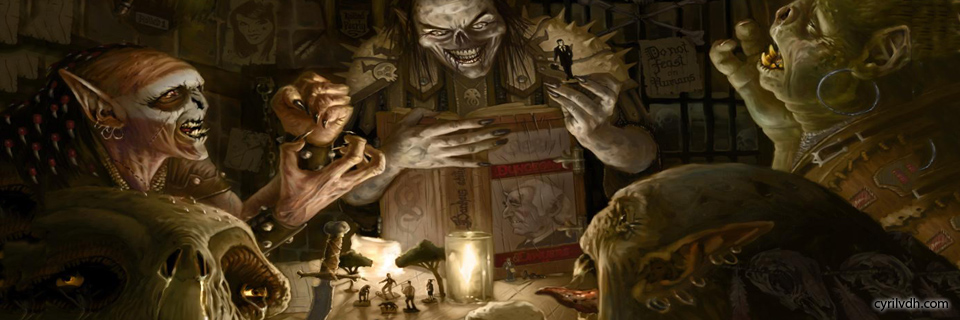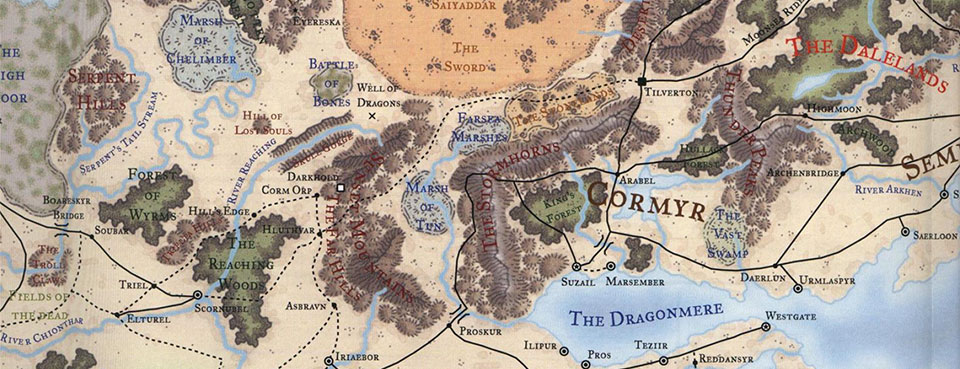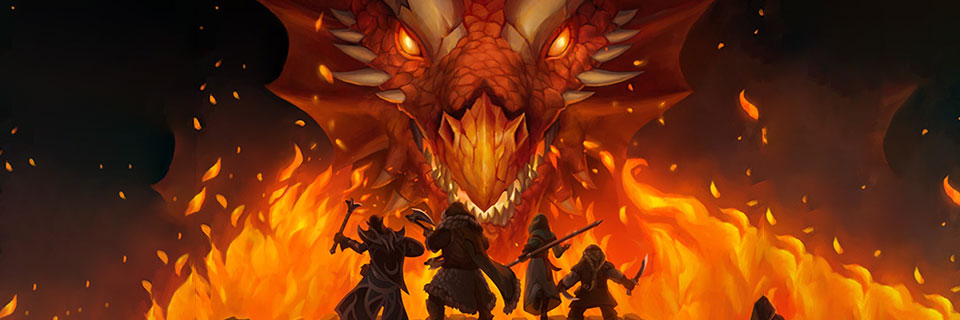Raineer teleports into the citadel of Thudheim looking for the McSillyputty cleric. He has great news of interest to the party – well certainly to anyone looking to make a name for themselves in the great North. For this info, he wants only 10% of the total take at the end.
Hellgate Keep has been exploded! Magic Itms are said to be scatttered across the slopes of the mountains nearby. Already, there have been reports of 100’s of adventuring parties showing up with bags of magic items. As a result the market has been somewhat flooded, leading to a crash in prices for certain items. He knows only sketchy details, but apparently this happened sometime within the last two-three years. A band of Harpers had successfully invaded the mountain complex near Neverwinter, seeking shards of a crystal. Those crystal shards were somehow used to construct a pyramid of eldrich power that detonated, leaving a smoking crater in the earth where Hellgate Keep once stood.
The Prehistory of Hellgate Keep Before humans first heard of Turnstone Pass or the Talons or the Land of Three Fords, the elves were here among the once-plentiful forests of the Upvale. In those early days the High Forest was more massive. What are now the Lurkwood, Moonwood, Silverwood, Everwood, Cold Wood, were all part of the same vast sweep of trees.
The elves had lived in temporary settlements (hunting lodges, seasonal villages, etc.) among the upper tributaries of the Delimbiyr for thousands of years, but the discomfiting rise of Netheril catalyzed them to react to the increased human activity in the region. EaerlannÃs elves had freely taught these humans magic, but the humans greedily plundered lost caches of magic from the ruined towers of Aryvandaar. Eaerlann, with whom the humans had early and continuing contact, merely cemented its borders and made them clearly known by their defensive fortresses such as the one built on the Horn, a natural peak along a bend in the western source stream of the Delimbiyr.
Less than four decades after AscalÃs Horn posted its first guards, the pompous archwizard Karsus brought ruin upon himself and his people by becoming a god (for a brief moment). Netheril fell with Karsusl. While many elves rejoiced over the end of the human nation of archwizards, they also took pity on the downtrodden and aimless masses of survivors of the Fall and took them under their protective wings. Within 30 years of the Fall, the elven fortress town of AscalÃs Horn became Ascalhorn, the town of magic, where human wizards relearned the less-abusive magics of the elves.
Later, though the elves colonized more of Faerûn, they returned to the High Forest to create other realms. Of all those realms, Eaerlann built the most fortresses and military posts within its lands and at its borders. Ostensibly, its inhabitants built them to protect themselves from the orcs whose hordes regularly swept across the frontier, but other historians have suggested the elves lived in fear of the rising human populations. Regardless of why they were built, the fortresses that dot the Upvale and the eastern High Forest today sprang from Eaerlann or were rebuilt Aryvandaarn posts. FarForest, and South Wood once were part of one greater forest, and the land therein was known among elves as Aryvandaar, which translates as High Forest/the Great Woodlands Home. With the Crown Wars, the elven civilization of Aryvandaar and its great forest began to splinter. Within a score of centuries, the northernmost
reaches of the High Forest split along the River Rauvin and the trees also thinned along the Delimbiyr, creating the Upvale.
Within a century, the town had grown such that only a few highly placed officials within it were elves and the bulk of the populace was primarily human. The elves of Eaerlann told themselves they had given the site over to the humans because they were better fit for the distasteful duty of continually guarding against the recurrent orc hordes.
When Myth Drannor rose in the eastern great forest of Cormanthor, Ascalhorn was among the first to ally itself with the City of Spells. A sister city to the greatest of all the races’ accomplishments, Ascalhorn grew great in arcane might along with Myth Drannor. However, without the guiding light of Coronal Eltargrim or his advisors, such as Myth Drannor
had, that power was quietly hoarded by elitists and paranoid mages rather than shared by all citizens to make Ascalhorn strong. Also during this time, Ascalhorn and Silverymoon grew close as fellow centers of learning on the the largely undeveloped North.
The Fall of Myth Drannor and the influx of elves and other wizards in and citizens from that realm toward Ascalhorn saw changes in the town. Many accepted the newcomers as fellow scholars and folk of knowledge, and the magic they brought from Myth Drannor was wondrous and happily safe from the Army of Darkness that ravaged their fallen city. However,
the flood of new wizards and elves also made many of Ascalhorn’s elitist wizards paranoid and afraid of losing their positions and their monopoly on power. This signaled the true start of Ascalhorn’s collapse. Various secret societies had begun to infiltrate the city, working for one faction ot another. This further reinforced the levels of paranoia and led to an ambattled air of palpable distrust about the place. Maerstar, a bard among the few humans who escaped the battles of the HornÃs Fall Incident and fled to safety, rechristened the town Hellgate Keep in one of his songs.
With assistance from the Red Wizards of Thay, the Cult of the Dragon, and the Zhentarim the wizards made a final grand grab for power when the hordes of demons were loosed upon the land. When the area was eventually threatened by the rising tide of demons, the wizards took control of the town, claiming that they alone could save the inhabitants. To combat the demons, the wizards raised an army of devils from hell and attempted to use them to destroy the demon horde. The devils saved the town from the demons, but slaughtered nearly everyone within the fortress, dominating the site and declaring it their territory. (This territorial claim was almost mandated by the lack of wizards to send the devils back to Hell.)
Grintharke, a balor and greatest of the devil’s commanders, immediately brought more of his kin over to Faerûn to reinforce his position. By late summer, GrintharkeÃs plans to ally with the orc hordes to bring down the Northern lands had nearly reached fruition. Given the fall of their northernmost defense into fiendish hands, the other cities of the North were ill-prepared to repel both a massive orc horde and the consolidated fiends of Hellgate Keep from their borders.
The Keep filled with more and more half-breeds of both human and orc descent. Barbarian tribes fell under the indirect influence of the Keep’s devils Humans were enslaved then slain and turned into ghouls, which were then unleashed all across the North. A premprtory strike aginst the citadel was suicidal, but to wait was to invite certain doom. While some of the Lords of the North (and Waterdeep) fought and died to destroy the devils’ leader and contain his lieutenants within Hellgate Keep on Midsummer, the others established powerful wards permeating the lands about the citadel. In addition to other effects useful against the Keep’s forces, its dweomer trapped any greater or true devil within the Keep’s walls, limiting their direct control over operations beyond the fortress to what they could exercise through their underlings. These wards also prevented them from summoning others of their kind as reinforcements. Immediate infighting amongst the devils reduced much of their strength, but a significant threat remained.
Since the binding of the city, it became much more open as outside contact was required in order to manipulate events. It was simple for two Harpers -the bard Cryshana Fireglen and Spellviper, a priest of Mystra – to Infiltrate the citadel as two more barbarians in the vast horde that challenged the city’s devilish population and forced compliance through sheer numbers, the barbarians outnumbering the others by at least five to one. The matriarchal leader of the Blu Bear barbarian tribe was Tanta Hagara. The Harpers allies then began attempting to lure Hagara and her forces forth or force her to overextend herself and make a tactical mistake by spreading rumors of gates and items of great power. These caught the attention of Tanta Hagara, for with control of those gates and items, she believed her tribe and Hellgate Keep could still conquer the North. She began pursuing these leads with scouts, reconnaissance parties, and finally whole units and small armies of troops.
Alustriel of Silverymoon and the Mistmaster of the Citadel of the Mists defended their own lands against the barbarian and cambion hordes that summer, though the High Forest also had the assistance of the treants of Turlang. Sundabar fell to the torch, but it was soon reestablished with only about a 25% loss of its people. A final rumor to Hagara’s ears fixed her sights on the Citadel of Mists: Here lay the Gatekeeper’s Crystal, she heard, which would allow her to cancel the wards around Hellgate Keep and bring in more troops to strengthen the tribe and the Keep.
Tanta Hagara assembled a huge army of more than 100 cambions and full devils and over 4000 Blue Bear tribesfolk and led them to attack the Mistmaster’s Citadel to gain the magics therein. Once the army was within a half day of the Citadel, the Mistmaster activated his own plan – for Cryshana and Spellviper each already held a piece of the Gatekeeper’s Crystal. Having positioned themselves atop western and eastern towers of the Keep, the two Harpers signaled the Mistmaster, who invisibly teleported just outside Hellgate Keep and activated the Crystal. The Crystal compressed the wards throughout the city, forcing an implosion that was immediately followed by an explosion of wild magic that shook the lands for more than 100 miles round. Nearly every building above and below ground was leveled by the explosion. Few, if any, within the Keep at the time survived.
Tanta Hagara, at the head of her army, did not have time to worry over the fate of her allies in Hellgate Keep, for she and her army soon fell to the MistmasterÃs defenses and the creatures of the High Forest, including the great treant Turlang.
With nearly one fell swoop, Hellgate Keep had fallen to ruin. Soon, Turlang and the treants blocked passage north at the confluence of the Heartblood and Delimbiyr rivers. Something of great power (some say Alustriel, others say galeb duhr allies of the Mistmaster, and still others say Turlang) caused an avalanche to seal Turnstone Pass and close the Upvale from any invaders. Travel into the area once occupied by Hellgate Keep is now limited to adventurers and other brave travelers willing to face the treants who now protect the ruins where Ascalhorn once rose.
But, Raineer continues, there is a vast array of magics that must stil lie within the city proper, or what is left of it and the dungeons below. Just from researvhing the original inhabitants of the city (before the devils took over) he knows of certainmagic items owned by city dwellers, such as:
Captain AeradÃs Shield: This medium-size round steel shield shatters any weapon it parried.
CraenmolÃs Hammer: This war hammer +3 sought out gold as much as its greedy owner did, shone like the sun, and rang like a loud temple bell whenever in the presence of the corrupting drow.
Dragonsheart Armor of King Connar IV of Armmarindar: The dragonsheart armor is a dwarf-size suit of red dragon scale mail with a full helm in the shape of a dragonÃs head. It provides AC 5 (equivalent to scale mail +1) and its wearer gains the following benefits: a +1 bonus on all saving throws vs. red dragon breath, fireball spells, and other attacks using heat or fire, and a -1 damage modifier to each and every damage die rolled (with a minimum of 1 point of damage per die) for such damage. In addition, attacks of this type that cause 6 points of damage or less in a round (whether initially or after being reduced by the -1 damage modifier per die) inflict no damage to the wearer.
Glove of Taarnahm the Vigilant: This chain mail gauntlet imbues any melee weapon its wearer grips with the flight abilities of a hammer +3, dwarven thrower but not the combat bonus.
Lashing Sword of Samos the Skullreaver: This Ammarindarn short sword trails an arc of magic that, if wielded like a whip against undead, destroys most undead creatures utterly with a touch.
Pegasus Helm of Kloeth Ironstar: This full helm +1 can summon a translucent pegasus twice a day to be used as a phantasmal mount.
Twinblades Alight: This unique vorpal battle axe has one half forged of black iron and the other of mithral.
TyrannyÃs Knell: This golden war hammer +3, dwarwen thrower causes earthquakes when slammed against the ground and shrinks giants by a foot with each blow.
Cheldaorn Katar: This punchblade dagger acts as a dagger of venom, but it never runs out of poison or needs to be refilled. It was carved by a renegade elf long ago from a black dragonÃs tooth.
NychyaellaÃs Healing Spear: This silver-headed shadowtop-wood spear can heal its wielder up to once per day by transferring all damage from the wielder into a successfully struck opponent on a successful attack roll of natural 20 and draining equal hit points to restore the wielder.
Shattering Swords of Coronal Ynloeth: These two blades form an artifact that once belonged to a former Coronal of Shantel Othreier before the Crown Wars. They can shatter once each year when intentionally clashed together in a specific manner, whereupon the long swords +2 become a swarm of ravenous razor shards that strip the wielder and any moving or living foe within a 30-foot radius of all life.
Shroudcrown: The Shroudcrown is an agate-studded bronze circlet artifact that allows the wearer to turn or control undead as a 10th-level priest, renders him or her immune to undead touch powers (like wraiths and liches possess), and makes him or her invisible and inaudible to unintelligent undead.
TasmiaÃs Heart: This elaborate high-necked bustier is laced and lined with black silk and adorned with sapphires and beljurils. It sustained the High Lady Tasmia’s life both underwater, functioning as a helm of underwater action and a ring of free action, and for centuries beyond measure, working in some unknown manner to slow her aging and preserve her life force.
Thyrsus of the Druid Craenoth Driel: The thyrsus is a staff topped with a massive pine cone and dedicated to Rillifane. It allegedly commands trees and treants alike to defend the wielder or perform missions of limited duration.
YnloethÃs Bracer: This artifact is a singular silver bracer of defense AC 2 made to be worn on the left arm. It is the only item that can protect a wielder against the effects of the Shattering Swords.










Yes, things are much easier when the crystal ball is working.
Hope they got all that. There was a lot of blank stares, but I think the elf was listening.That’s one I’m tempted to go on but tempted is only a word.
The castle life is rapidly growing comfortable, but I still hunger for the high stakes game.
If I hear one more shopkeeper whining about something or some shit bag peasant tugging on my sleeve, some one is going to be target practice.
Focus man, you’ve got two more errands and a top
of the line whore waiting in Waterdeep. Funny how the “good” town has the best whores. Those clerics do like virgins. Who doesn’t? Focus……Now!
I think the magic quill is out of ink…